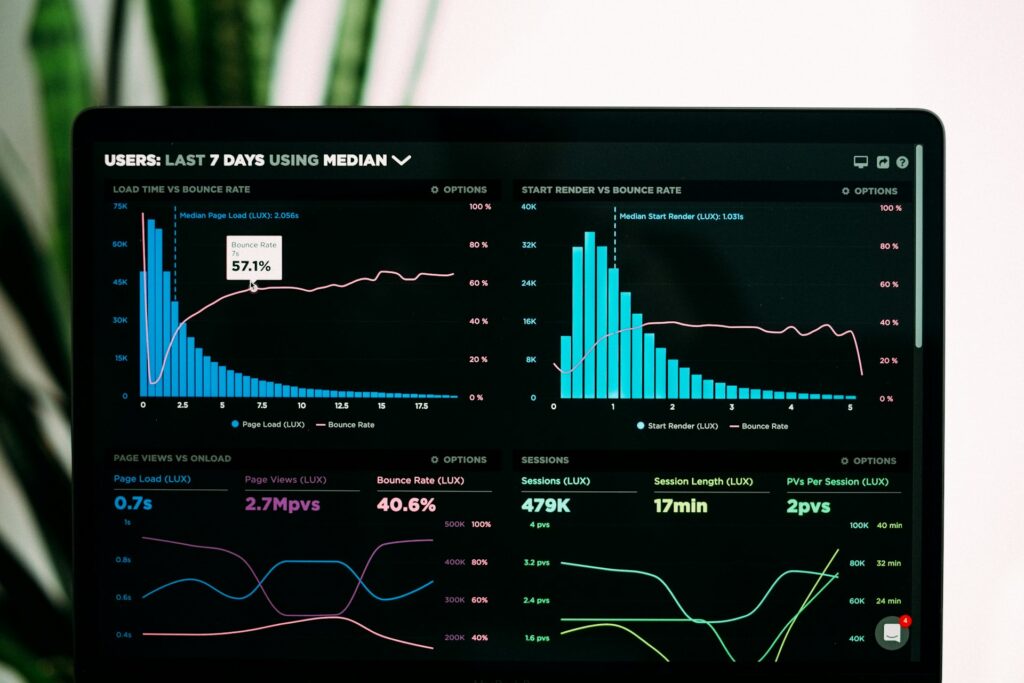
Content marketing can increase your organic traffic, boost your domain rating and get new prospects interested in what you offer. To achieve all this, though, it’s crucial to track your data and adapt your strategy.
These content marketing metrics act as a tool to figure out what’s effective, what’s not, and how to stand out in the crowded digital space.
In this blog post, we break down the importance of data, explore which content marketing metrics to track, and explain how to actually do it!
Get ready to experience the rewards of measurable marketing.
What are content marketing metrics?
Content marketing metrics are the vital signs of your digital strategy. They’re the numbers that reveal how your content is performing and where you need to improve.
From your traffic and bounce rate to engagement and conversion rate, these metrics will enable accurate reporting and – more importantly – help you get better results.

Top content marketing metrics to track
Content marketing metrics for visibility:
1. Views
Views tell you how many times your content has been accessed by users. This metric sheds light on the extent of your content’s visibility and the topic’s resonance with your target audience.
It’s probably the first metric you’ll check. But it’s important to remember that a ‘view’ doesn’t mean they engaged with the content, reached the end or even read it at all. Tracking views provides a baseline understanding of the content’s popularity.
2. User Sessions
You should also track the number of unique visits to your website or blog. Remember: some users will go on to read other posts and some might read this one more than once.
This content marketing metric helps you evaluate overall engagement, measure the real interest your content generates, and identify patterns in user behaviour.
3. Keyword Rankings
Keyword rankings assess where your content stands in search engine results for specific terms. By monitoring these rankings, you can optimise your content to improve visibility.
Did you know that long-tail keywords drive 68% of organic traffic for blogs but only 3% of SEO budgets? (Ahrefs, 2023). If your rankings aren’t high enough, try optimising for more long-tail terms!

4. Impressions
Impressions represent how often your content appears on users’ screens, whether in search results or on social media feeds.
This metric serves as a barometer for content visibility. Use it to examine your potential reach and the effectiveness of your distribution channels.
5. Backlinks
The backlink metric tells you the number of external websites linking to your content. Backlinks are a crucial component of SEO, as they communicate to Google the perceived authority and relevance of your content. Building quality backlinks enhances your site’s credibility and search engine ranking.
Long-form content (over 2,000 words) tends to get 77% more backlinks than shorter content. (Backlinko). Consider producing more comprehensive blog posts to increase your number of backlinks.
6. Video Views
Video conversions are 54% higher than non-video conversions. (Wordstream). Before analysing your conversion rate, though, measure how many times your videos are viewed.
Tracking video views helps you gauge:
- to what extent your audience is interested in video content
- the effectiveness of your video titles and thumbnails
- the strength of your video’s SEO
7. Email Marketing Open Rate
A newsletter open rate indicates the percentage of subscribers who open your emails. A higher open rate suggests that your subject line and preview text resonate with your audience.
For more on this, read our comprehensive guide to email marketing metrics.
Content marketing metrics for engagement:
8. Bounce Rate
Bounce rate measures the percentage of visitors who navigate away from your site after viewing only one page. A high bounce rate may indicate disinterest or mismatched expectations. To reduce your bounce rates, you need to optimise the content and user experience to keep visitors engaged and exploring.
The average scroll depth on blog posts is only 60% (UXtweak) – so you need to pique interest early on. Highlight what readers should do after reading this post, whether that’s visiting another page on your site or taking a specific action.
9. Average Engagement Time
Many analytics tools will calculate the average duration of time visitors spend interacting with your content. This metric is a gauge of content relevance and interest. You want users to spend as long on your site as possible, and this metric also influences your SERP rankings.
Try to beat the B2B average blog post engagement time of 1 minute 30 seconds!
10. Engagement Rate
Your engagement rate puts a number on the level of interaction your content receives. It combines likes, shares, comments, and other interactions. A high engagement rate suggests a strong connection with your audience, whether through your blog or social media marketing.
Content marketing metrics for community growth:
11. Traffic Sources
Traffic source data helps you understand where your audience is coming from. Do you get more leads from Google and other search engines, social media, email or direct?
Analysing these sources helps you tailor your lead generation strategy to build your community faster. See which channels are giving you the highest ROI (return on investment) and put your money into the most profitable outreach.

– Barry Fagan, Lead Data and Tracking Specialist
12. Brand Mentions
Track instances where your brand or content is referenced online. Brand mentions can occur in social media, blogs, or other digital platforms. Monitoring them helps you to gauge brand awareness and the organic growth of your community.
13. Social Shares
You should also monitor how often your content is shared on social media platforms. This metric reflects the social resonance of your content and potential for community engagement.
Looking to create more shareable content? Whether it’s an article, a video or an infographic, the content most likely to get social shares does one of the following:
- Offers a unique take
- Provides valuable information
- Provokes a conversation
14. Follower Growth
Follower growth measures the increase in your social media followers over time. This metric is a direct indicator of your community’s expansion and the effectiveness of your content in attracting and retaining followers.
Compare your growth rate across different platforms to see what’s working and where your community is.
15. Subscriber Growth
You should also track the rate of increase in your email or newsletter subscribers. A growing subscriber base can have a huge impact on a business’s success. This metric helps you determine how well your lead generation strategy is working.
If your growth rate slows, you should also check your unsubscribe rate. It might be that you’re sending too many emails or you need to do more segmentation.
Content marketing metrics for ROI (return on investment):
16. Conversion Rate
The conversion rate calculates the percentage of visitors who take the desired action after viewing your content. This action might be buying a product, signing up to a mailing list, or downloading a whitepaper.
It basically tells you how effective your content is!
To calculate your conversion rate, you’ll need to determine the desired action (just one!) and divide the number of visitors by the number of users who completed the action.
17. CTR (Click-Through Rate)
Your click-through rate is the percentage of users who click on a specific link, often in an email or ad. A higher CTR indicates that your content or call-to-action is compelling and prompts user engagement.
Measure the efficiency of your content in driving traffic and achieving desired outcomes.
Our top tip for improving your CTR is to personalise the content you put out and even the links you include. 71% of B2B buyers say personalisation significantly increases their purchase likelihood. (McKinsey).

How to track your metrics for content marketing
Start by defining clear objectives tailored to your business goals. Then find robust analytics tools and configure them to monitor the metrics aligned with your objectives.
It’s important to implement conversion tracking on your CMS. This way, you can directly tie your content efforts to measurable outcomes.
Keep your metrics dynamic, updating and optimising them as your content strategy evolves.
We’ve found a data-driven approach is the key to sustained success!
Tried and tested content marketing metrics software and tools
It’s important to use the latest analytics and metric monitoring tools – relying on your CMS’s in-built analytics won’t get you very far. Good marketing metrics tools provide actionable insights that decode user behaviour, measure campaign effectiveness, and guide strategic adjustments.
Explore the tools we use here at Digivate:
- Google Analytics (GA4): Every marketer should be using the latest version of Google Analytics! It’s probably the most powerful tool out there for comprehensive website analytics and user behaviour insights. And it’s completely free.
- Google Search Console: When it comes to SEO, Google Search Console has data relating to all your key metrics. Monitor search performance, fix issues, and prepare to optimise the heck out of your content.
- Semrush, Ahrefs, and Moz: We also recommend exploring these dedicated platforms for in-depth keyword analysis, backlink tracking, and competitor insights.
Our top tips for tracking your content marketing metrics:
- Integrate Customer Relationship Management (CRM) systems for a holistic view of the customer journey. These will help you connect content interactions to lead generation and sales.
- Incorporate UTM parameters into your URLs for accurate tracking of traffic sources.
- Implement goal tracking within your analytics tools to monitor specific actions tied to your content objectives.
Want to get even more from your Google Analytics data? Learn how to navigate the Google Analytics interface, which reports are available, how to use these reports, and manage the data you send → https://t.co/8uqWYgbA3V pic.twitter.com/5t7YtkgZzT
— Google Analytics (@googleanalytics) October 25, 2023
Next step: content marketing triumph
Mastering your metrics is the key to a successful content marketing strategy. By understanding your audience, optimising your approach, and adapting to data-driven insights, you can unlock the full potential of your content.
Ready to delve deeper into your metrics and get more converts from your content?
Our specialists in content marketing, SEO and analytics will develop a custom content marketing strategy that truly engages your target audience. Get in touch to find out how we can triple your engagement in three months.



